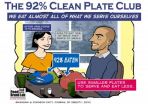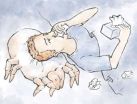(Press-News.org) PHILADELPHIA (July 22, 2014) – New research from the Monell Center reveals that simply believing that an odor is potentially harmful can increase airway inflammation in asthmatics for at least 24 hours following exposure. The findings highlight the role that expectations can play in health-related outcomes.
"Asthmatics often are anxious about scents and fragrances. When we expect that an odor is harmful, our bodies react as if that odor is indeed harmful," said study lead author Cristina Jaén, PhD, a Monell physiologist. "Both patients and care providers need to understand how expectations about odors can influence symptoms of the disease."
Asthma is a chronic inflammatory disorder of the lungs. According to the National Institutes of Health, over 25 million Americans have the disease, which can interfere with quality of life. The airways of asthmatics are sensitive to 'triggers' that further inflame and constrict the airways, making it difficult to breathe. There are many different types of triggers, including pollen, dust, irritating chemicals, and allergens. Strong emotions and stress also can act to trigger asthma symptoms.
Because asthma has no cure, it is important for individuals with the disease to understand how to manage their symptoms to help prevent severe asthma attacks.
Many health organizations list scents and fragrances as asthma triggers, leading patients to become anxious when exposed to environmental odors. The current research was conducted to determine whether odor-triggered asthma symptoms can be elicited or worsened by associated negative expectations.
In the study, published online ahead of print in the Journal of Psychosomatic Research, 17 individuals characterized as moderate asthmatics were exposed to the odor phenylethyl alcohol (PEA) for 15 minutes. Often described as rose-smelling, PEA is regarded as a 'pure' odorant with no associated physiological irritant qualities.
Eight subjects were told that the odor had potential therapeutic properties, while nine were told that it potentially could cause mild respiratory problems.
During odor presentation, the subjects rated the odor's sensory properties, including intensity, irritancy, and annoyance. Measures of lung function and airway inflammation were collected before and immediately after exposure and again at two hours and 24 hours post-exposure.
Subjects' beliefs about the odor, specifically whether it was potentially harmful (asthma-triggering) or therapeutic, influenced both their psychological and physiological responses to odor exposure.
Individuals who were told that the odor was potentially harmful rated it as more irritating and annoying as compared to those who thought it might be therapeutic.
In addition, airway inflammation increased immediately following odor exposure in subjects who believed the odor might be harmful and remained elevated 24 hours later.
"Introducing a negative bias led to a rapid change in airway inflammation," said senior author Pamela Dalton, PhD, a cognitive psychologist at Monell. "What really surprised us was that this response lasted for over 24 hours. The increased inflammation during this period likely makes asthmatics more sensitive to other triggers."
There was no increase of inflammation when the odor was characterized as therapeutic, even in individuals who described themselves as sensitive to perfumes and other odors.
The findings suggest that some fragrance effects on asthma symptoms may be related to the expectation of harm as opposed to chemical properties of the odor.
"It's not just what you smell, but also what you think you smell," said Jaén.
Looking forward, the researchers want to identify the biological mechanisms that connect expectations to airway inflammation. They also intend to explore whether a reverse phenomenon also exists. Dalton asks, "Can we improve health outcomes by reducing concern or fear in a disease where emotional arousal is counter-productive?"
INFORMATION:
Research reported in the publication was supported by a grant from the National Institute on Deafness and Other Communication Disorders (R01DC06760) of the National Institutes of Health. The content is solely the responsibility of the authors and does not necessarily represent the official views of the National Institutes of Health.
The Monell Chemical Senses Center is an independent nonprofit basic research institute based in Philadelphia, Pennsylvania. For 46 years, Monell has advanced scientific understanding of the mechanisms and functions of taste and smell to benefit human health and well-being. Using an interdisciplinary approach, scientists collaborate in the programmatic areas of sensation and perception; neuroscience and molecular biology; environmental and occupational health; nutrition and appetite; health and well-being; development, aging, and regeneration; and chemical ecology and communication. For more information about Monell, visit http://www.monell.org.
In asthma, it's not just what you smell, but what you think you smell
Cognitive expectations about odor safety related to airway inflammation
2014-07-22
ELSE PRESS RELEASES FROM THIS DATE:
The dopamine transporter
2014-07-22
Recent published research in the Journal of Clinical Investigation demonstrates how changes in dopamine signaling and dopamine transporter function are linked to neurological and psychiatric diseases, including early-onset Parkinsonism and attention deficit hyperactivity disorder (ADHD).
"The present findings should provide a critical basis for further exploration of how dopamine dysfunction and altered dopamine transporter function contribute to brain disorders" said Michelle Sahai, a postdoctoral associate at the Weill Cornell Medical College of Cornell University, ...
Alaska frogs reach record lows in extreme temperature survival
2014-07-22
Freezing and thawing might not be good for the average steak, but it seems to help wood frogs each fall as they prepare to survive Alaska's winter cold.
"Alaska wood frogs spend more time freezing and thawing outside than a steak does in your freezer and the frog comes back to life in the spring in better shape than the steak," said Don Larson, University of Alaska Fairbanks graduate student and lead author on a recent paper demonstrating that freeze tolerance in Alaska wood frogs is more extreme than previously thought.
Although wood frogs are well-studied freeze-tolerant ...
Study examines presence of uterine cancers at the time of hysterectomy using morcellation
2014-07-22
Among women undergoing a minimally invasive hysterectomy using electric power morcellation, uterine cancers were present in 27 per 10,000 women at the time of the procedure, according to a study published by JAMA. There has been concern that this procedure, in which the uterus is fragmented into smaller pieces, may result in the spread of undetected malignancies.
Despite the commercial availability of electric power morcellators for 2 decades, accurate estimates of the prevalence of malignancy at the time of electric power morcellation (in this study referred to as morcellation) ...
The 92 percent clean plate club
2014-07-22
If you're a member of the Clean Plate Club – you eat pretty much everything you put on your plate – you're not alone! A new Cornell University study shows that the average adult eats 92% of whatever he or she puts on his or her plate. "If you put it on your plate, it's going into your stomach," says Brian Wansink Ph.D., author of the forthcoming book, Slim by Design, Professor of Marketing and Director of the Cornell Food and Brand Lab.
Wansink and co-author Katherine Abowd Johnson analyzed 1179 diners and concluded that we're a Clean Plate Planet. Although diners ...
Essays in English yield information about other languages
2014-07-22
Computer scientists at MIT and Israel's Technion have discovered an unexpected source of information about the world's languages: the habits of native speakers of those languages when writing in English.
The work could enable computers chewing through relatively accessible documents to approximate data that might take trained linguists months in the field to collect. But that data could in turn lead to better computational tools.
"These [linguistic] features that our system is learning are of course, on one hand, of nice theoretical interest for linguists," says Boris ...
NASA's Fermi finds a 'Transformer' pulsar
2014-07-22
VIDEO:
Zoom into an artist's rendering of AY Sextantis, a binary star system whose pulsar switched from radio emissions to high-energy gamma rays in 2013. This transition likely means the pulsar's...
Click here for more information.
In late June 2013, an exceptional binary containing a rapidly spinning neutron star underwent a dramatic change in behavior never before observed. The pulsar's radio beacon vanished, while at the same time the system brightened fivefold in gamma rays, ...
Forty-five percent rise in diagnostic imaging tests by GPs -- new study
2014-07-22
A 45 per cent rise in diagnostic imaging tests ordered by Australian GPs is being driven by increasing GP visits, a rising number of problems managed at consultations and a higher likelihood that GPs order imaging tests for these problems, according to a new University of Sydney study released today.
Based on a long term national survey of 9,802 GPs between 2002 and 2012, the report draws on data from more than 980,000 GP-patient encounter records to assess the extent to which GP's order tests in line with diagnostic imaging guidelines.
"Most imaging tests ordered by ...
Gene variant identified as a heart disease risk factor for women
2014-07-22
When it comes to heart disease, Dr. Ross Feldman says women are often in the dark. Historically, it was thought that heart disease was a men's-only disease, however, data has shown that post-menopausal women are just as likely as men to get heart disease and are less likely to be adequately diagnosed and treated. New research from Western University published online this week in the British Journal of Clinical Pharmacology brings to light a genetic basis for heart disease in women and helps to identify which women are more prone to heart disease.
The study, led by Dr. ...
Researchers create vaccine for dust-mite allergies
2014-07-22
If you're allergic to dust mites (and chances are you are), help may be on the way.
Researchers at the University of Iowa have developed a vaccine that can combat dust-mite allergies by naturally switching the body's immune response. In animal tests, the nano-sized vaccine package lowered lung inflammation by 83 percent despite repeated exposure to the allergens, according to the paper, published in the AAPS (American Association of Pharmaceutical Scientists) Journal. One big reason why it works, the researchers contend, is because the vaccine package contains a booster ...
Activity level may predict orthopedic outcomes
2014-07-22
According to a literature review in the July issue of the Journal of the American Academy of Orthopaedic Surgeons (JAAOS), patients' activity level is a strong predictor for how well they will do with certain treatments and how well they recover from injuries after treatment. Patients are encouraged to ask their orthopaedic surgeon if activity level is an important factor in their treatment decision. For example, more active patients are at a higher risk of re-injury after an anterior cruciate ligament (ACL) reconstruction, and activity level should be considered when deciding ...
LAST 30 PRESS RELEASES:
Decoupling the HOR enhancement on PtRu: Dynamically matching interfacial water to reaction coordinates
Sulfur isn’t poisonous when it synergistically acts with phosphine in olefins hydroformylation
URI researchers uncover molecular mechanisms behind speciation in corals
Chitin based carbon aerogel offers a cleaner way to store thermal energy
Tracing hidden sources of nitrate pollution in rapidly changing rural urban landscapes
Viruses on plastic pollution may quietly accelerate the spread of antibiotic resistance
Three UH Rainbow Babies & Children’s faculty elected to prestigious American Pediatric Society
Tunnel resilience models unveiled to aid post-earthquake recovery
Satellite communication systems: the future of 5G/6G connectivity
Space computing power networks: a new frontier for satellite technologies
Experiments advance potential of protein that makes hydrogen sulfide as a therapeutic target for Alzheimer’s disease
Examining private equity’s role in fertility care
Current Molecular Pharmacology achieves a landmark: real-time CiteScore advances to 7.2
Skeletal muscle epigenetic clocks developed using postmortem tissue from an Asian population
Estimating unemployment rates with social media data
Climate policies can backfire by eroding “green” values, study finds
Too much screen time too soon? A*STAR study links infant screen exposure to brain changes and teen anxiety
Global psychiatry mourns Professor Dan Stein, visionary who transformed mental health science across Africa and beyond
KIST develops eco-friendly palladium recovery technology to safeguard resource security
Statins significantly reduce mortality risk for adults with diabetes, regardless of cardiovascular risk
Brain immune cells may drive more damage in females than males with Alzheimer’s
Evidence-based recommendations empower clinicians to manage epilepsy in pregnancy
Fungus turns bark beetles’ defenses against them
There are new antivirals being tested for herpesviruses. Scientists now know how they work
CDI scientist, colleagues author review of global burden of fungus Candida auris
How does stroke influence speech comprehension?
B cells transiently unlock their plasticity, risking lymphoma development
Advanced AI dodel predicts spoken language outcomes in deaf children after cochlear implants
Multimodal imaging-based cerebral blood flow prediction model development in simulated microgravity
Accelerated streaming subgraph matching framework is faster, more robust, and scalable
[Press-News.org] In asthma, it's not just what you smell, but what you think you smellCognitive expectations about odor safety related to airway inflammation




